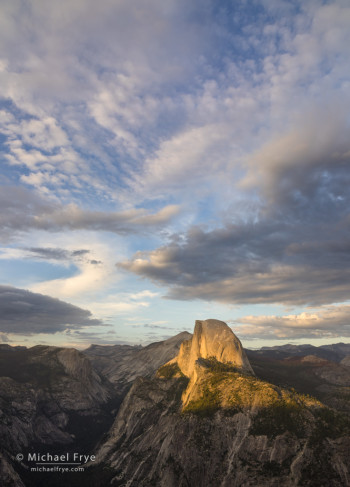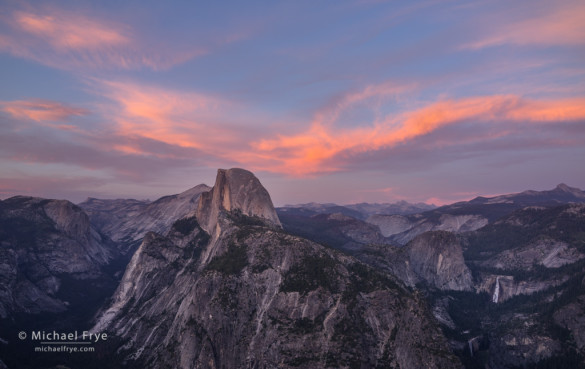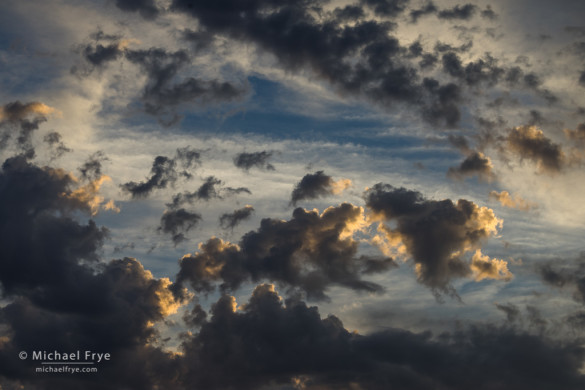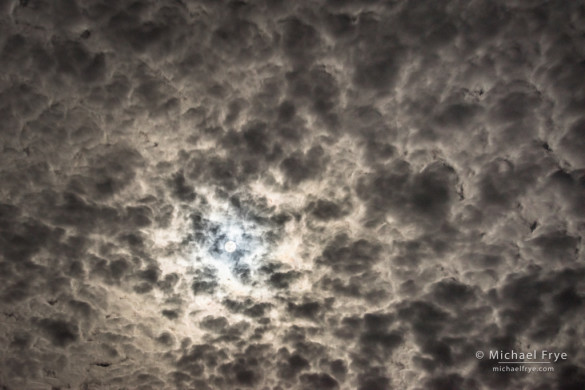
Half Dome from Glacier Point, late afternoon, Yosemite; for a brief moment the clouds formed a zigzag pattern above Half Dome.
Last week I mentioned that the weather forecast called for monsoonal moisture to move up into the Sierra Nevada from the south, with possible showers and thunderstorms. And sure enough, things unfolded pretty much as predicted. Rain was very localized; we got sprinkled on a couple of times at our house in Mariposa, but other nearby areas got dumped on when they received a direct hit from a thunderstorm.
Wednesday night brought thunder to the foothills near our house – that’s when I made the lightning photograph from my last post. But we saw interesting clouds all week. Claudia and I made two trips to Glacier Point, and I also photographed some beautiful moonlit clouds from our driveway, and made a trip into the lower foothills, where I found some striking, colorful sunbeams.
What do all these photographs have in common – aside from clouds? Patterns. All of these images have some kind of repeating pattern or design in the clouds.
Finding patterns is one of the most essential, fundamental compositional skills. Repeating patterns create unity, cohesion, and rhythm, and our brains just love them. Since landscape photographs are often as much about the atmosphere as the land, it pays to look for patterns in the clouds. Some of the patterns I found last week were pretty obvious, like the repeating small puffy shapes around the moon in the second photograph below. Others were more subtle, like the zigzag design in the clouds above Half Dome in the image above.
Like anything, learning to recognize patterns takes practice. But you can practice almost anywhere. Try looking for patterns while sitting in traffic, or waiting in a line. The more you look for patterns, the more easily you’ll recognize them, and that skill will pay off when you look for designs in fast-moving clouds.
The forecast calls for more showers and thunderstorms in the Sierra high country this week – which means more good weather for photography, and more opportunities to look for patterns in the clouds.
— Michael Frye

Half Dome from Glacier Point at sunset, Yosemite; this photograph doesn’t have strong repetition, but the band of orange clouds has a wave-like shape that’s faintly mirrored in the landforms below.

Sunset clouds, Mariposa County, CA, USA; small, jagged shapes repeat throughout the frame, and there’s also a subtle, semi-circular design to the photograph.

Sunbeams in the Sierra Nevada foothills at sunset, Mariposa County; the sunbeams create a radiating design that cuts through repeating horizontal layers.
Related Posts: Photography Weather; Fireworks; Finding Rhythm
Did you like this article? Click here to subscribe to this blog and get every new post delivered right to your inbox!
Michael Frye is a professional photographer specializing in landscapes and nature. He is the author or principal photographer of The Photographer’s Guide to Yosemite, Yosemite Meditations, Yosemite Meditations for Women, Yosemite Meditations for Adventurers, and Digital Landscape Photography: In the Footsteps of Ansel Adams and the Great Masters. He has also written three eBooks: Light & Land: Landscapes in the Digital Darkroom, Exposure for Outdoor Photography, and Landscapes in Lightroom 5: The Essential Step-by-Step Guide. Michael has written numerous magazine articles on the art and technique of photography, and his images have been published in over thirty countries around the world. Michael has lived either in or near Yosemite National Park since 1983, currently residing just outside the park in Mariposa, California.










Beautiful, and I’m so glad to hear some moisture came to the area. The sunset at Glacier Point reminds me of the picture I took 3 years ago. It was my dads last trip to Yosemite, bittersweet, but fond memories? I’d love to share my picture with you, but not sure how to. Thanks for yours posts and pictures.
Thanks Lisa! The best way to share your photo is to put it online somewhere (your website, Flickr, Facebook, or whatever) and post a link to it here.
Michael-
Pictures are really good, very sharp and clear. I am very new to this photography and still trying to figure it out different settings in the camera. Would you ming telling the camera setting you used for your first picture.
Thanks
Trisha
Thanks Trisha. The settings for the first photo were 1/20th of a second at f/11, 100 ISO.